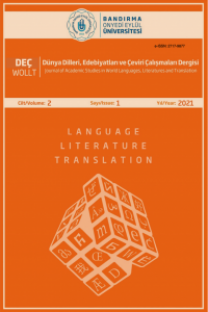Çocuk Edebiyatında Postkolonyel Göstergelerin ve Çevirilerinin Çeviri Göstergebilimi Bakış Açısıyla Çözümlenmesi
Bu çalışmanın amacı, Rudyard Kipling’in (1902) “How the Camel Got His Hump” başlıklı kısa öyküsündeki yerdeşlikleri incelemek ve Türkçe çevirilerini değerlendirmektir . Bu amaç doğrultusunda, Sündüz Öztürk Kasar’ın çeviri göstergebilimine yaklaşımı çerçevesinde önerdiği çözümleme adımlarından biri olan “Metindeki Oluşan Yerdeşliklerin Değerlendirilmesi” üzerine temellenen bir özgün metin çözümlemesi yapılmıştır (Öztürk Kasar, 2009a). Göstergebilimsel çözümleme sonucunda, kısa öyküde ideolojiye gönderme yapan beş yerdeşlik tespit edilmiştir. Yerdeşlikler, Edward Said’in (1979) “Oryantalizm” kavramına dayalı olarak sömürgecilik sonrası bir bakış açısıyla tartışılmıştır . Kısa öykünün iki Türkçe çevirisinde yer alan yerdeşlikler Sündüz Öztürk Kasar’ın “Anlam Bozucu Eğilimler Dizgeselliği” (Öztürk Kasar ve Tuna, 2017, s. 172) çerçevesinde değerlendirilmiştir. Çeviri değerlendirmesi bölümünde on beş anlam bozucu eğilim tespit edilmiştir. Elde edilen bulgular, çevirmenlerin muğlak bir metin olan ve ideolojik göndermeler içeren kısa öyküyü çevirme sürecinde karşılaştıkları güçlükleri göstermektedir. Bu çalışma, yazınsal çeviri edimini yerine getirebilmek için çevirmenin göstergebilimsel çözümlemeden yararlanabileceğini öne sürmektedir. Bu bağlamda, göstergebilimsel çözümlemenin anlam evrenini alımlamaya katkıda bulunduğu ve muğlak bir metnin derin anlamlarının kavranmasını sağladığı söylenebilir. Bu bulgular ve önermeler ışığında, çeviri göstergelimi, çevirmene etkili bir şekilde rehberlik edebilir ve muğlak metinde yer alan ideolojik göndermeler üzerine bir farkındalık yaratabilir.
Anahtar Kelimeler:
çeviri göstergebilimi, yerdeşlikler, sömürgecilik sonrası bakış açısı, çocuk edebiyatı, ideoloji
Analysis of Isotopies and Turkish Translations of the Short Story Entitled “How the Camel Got His Hump” from Postcolonial Perspective through Semiotics of Translation
The aim of this study is to analyze the isotopies in the short story titled “How the Camel Got His Humph” by Rudyard Kipling (1902), and evaluate Turkish translations of the short story. To this end, the source text was analyzed based on “isotopies in the text” which is one of the analysis steps suggested by Sündüz Öztürk Kasar within the framework of her approach to semiotics of translation (Öztürk Kasar, 2009). As a result of semiotic analysis, five isotopies including ideological implications were detected. The isotopies were discussed from a postcolonial perspective based on the concept “Orientalism”. The isotopies in two Turkish translations of the short story were evaluated within the framework of Sündüz Öztürk Kasar’s “Systematics of Designification in Translation” (Öztürk Kasar and Tuna, 2017: 172). Sixteen designificative tendencies were found in the translation of evaluation part. The findings show that translators face with challenges in the process of translating the short story that is ambivalent text including ideological implications. This study suggests that the translator can benefit from semiotic analysis and semiotic translation. Semiotics contributes to significance in the meaning universe and makes it possible to grasp deep meanings of an ambivalent text. Semiotic translation guides the translator efficaciously and create an awareness about ideological implication in an ambivalent text.
Keywords:
semiotics of translation, isotopies, postcolonial perspective, children's literature, ideology,
___
- Emmer, P. C. (1990). European Expansion and Migration; the European Colonial Past and Intercontinental Migration. An Overview. Itinerario, 14(1), 11-24.
- Ludskanov, A. (1975) “A Semiotic Approach to the Theory of Translation”, Language Sciences, (p.31)
- McCallum, R., & Stephens, J. (2011). Ideology and children’s books. In Handbook of research on children's and young adult literature (pp. 371-385). Routledge.
- Öztürk Kasar, S. (2001) “La Sémiotique Subjectale et la Traduction”, Third International Congress Claims, Changes and Challenges in Translation Studies Abstracts, European Society for Translation Copenhagen Business School-Copenhagen.
- Öztürk Kasar, S. (2009). Pour une sémiotique de la traduction, [Toward the semiotics of translation]. La Traduction et ses Métiers. C. Laplace, M. Lederer & D. Gile (Eds.). Caen: Lettres Modernes Minard, Coll, 163-175.
- Öztürk Kasar, S. (2012). Jean-Claude Coquet ile bir dil görüngübilimine doğru. XII. Uluslararası Dil, Yazın ve Deyişbilim Sempozyumu Bildiriler Kitabı, pp. 427-433. Edine: Trakya University
- Öztürk Kasar, S. (2016a) “Sémiotique de la Traduction Littéraire”, Les Langues Modernes, Dossier: Approches Théoriques de la Traduction, 1: 43-51.
- Öztürk Kasar, S. & Tuna, D. (2017, April). Shakespeare in three languages: Reading and analyzing Sonnet 130 and its translations in light of semiotics. IJLET International Journal of Languages' Education and Teaching. 5(1), 170-181. Doi: 10.18298/ijlet.1723. Retrieved from www.ijlet.com.
- Kipling, R. (2007). İşte öyle hikayeler (B. Kovulmaz, Trans.). İstanbul: Türkiye İş Bankası Kültür Yayınları.
- Kipling, R. (2012). Kipling’den sevilen çocuk hikayeleri (R. Yıldırım, Trans.). Ankara: Elips Kitap
- Kipling, R. (1902). Just so stories. Feedbooks.
- Lathey, G. (2016). Translating Children's Literature. Routledge.
- Said, Edward W. (1978 [1995]) Orientalism: Western Conceptions of the Orient, London: Penguin.
- Said, E. W. (1979). Orientalism. Vintage.
- Stecconi, U. (2007). Five reasons why semiotics is good for translation studies. Y. Gambier, M. Shlesinger and R. Stolze (Ed.), Doubts and directions in translation studies (pp. 15-26). Amsterdam: John Benjamins Publishing Company Stephens, J. (1992). Language and ideology in children's fiction. Longman.
- Torop, P. (2000). Towards the semiotics of translation. Semiotica, 128(3-4), 597-610.
- Yayın Aralığı: Yılda 2 Sayı
- Başlangıç: 2020
- Yayıncı: Bandırma Onyedi Eylül Üniversitesi
Sayıdaki Diğer Makaleler
Logos, Dilde Çözümsüz Bir Çelişki Midir?
Jean Claude COQUET, Çevirmen: Sündüz KASAR
Hamdullah Hamdi'nin Yusuf U Züleyha Mesnevisi Bağlamında Züleyha'nın Femme Fatale Kişiliği
Hamdullah Hamdi'nin Yusuf U Züleyha Mesnevisi Bağlamında Züleyha'nın Femme Fatale Kişiliği
Sabahattin Ali'nin "Birdenbire Sönen Kandilin Hikayesi"ndeki Gotik Unsurlar
XVI. Asır Aşk Mesnevilerinde Güzelin Tasviri
L’enseignement Marocain Face Au Confinement: Enjeux et Solutions
Sabahattin Ali'nin "Birdenbire Sönen Kandilin Hikayesi"ndeki Gotik Unsurlar
